Do you have everything you need for a quick evacuation? This Ultimate Bug Out Bag (BOB) Guide is here to help. It will ensure you pack all the bug out bag essentials for any sudden crisis.
Our list covers everything from food and water to shelter and ways to communicate. We’ve looked to the Centers for Disease Control (CDC) and Ready.gov for the best advice. They help us show you how to build a perfect 72 hour kit for your specific needs.
Ready.gov states it’s key to have enough food and water for at least 72 hours after a disaster. You should also have a flashlight, first aid kit, necessary medicines, and local maps. Our guide adds these and more to ensure you’re ready for anything.
Understanding the Bug Out Bag: Definition and Purpose
Let’s start with a basic question: What is a Bug Out Bag? It’s a portable kit to help you last at least 72 hours in an emergency. These bags are key for unexpected situations. This can include natural disasters like floods and hurricanes or human-caused events such as fires or civil unrest.
The bag’s main goal is to prep you to leave quickly. It acts as your personal emergency kit. With it, you can head out with everything you need, ready to face any crisis confidently.
Here’s a look at different Bug Out Bags to help pick the best one for you:
| Type | Recommended Model | Capacity | Ideal For |
|---|---|---|---|
| Tactical | 5.11 RUSH 72 2.0 Backpack | 55L | Comprehensive survival gear |
| Wilderness | TETON Scout 55 Backpack | 55L | Wilderness adventures |
| Discreet | 5.11 COVRT24 Backpack | 41L | Urban areas |
Having your Bug Out Bag ready can make a huge difference. It shifts you from being at risk to being safe. So, ensure it’s filled with all essential items for emergencies. It should also be easy to carry and grab fast when you have to bolt.
Choosing the Right Bag: Types and Tips
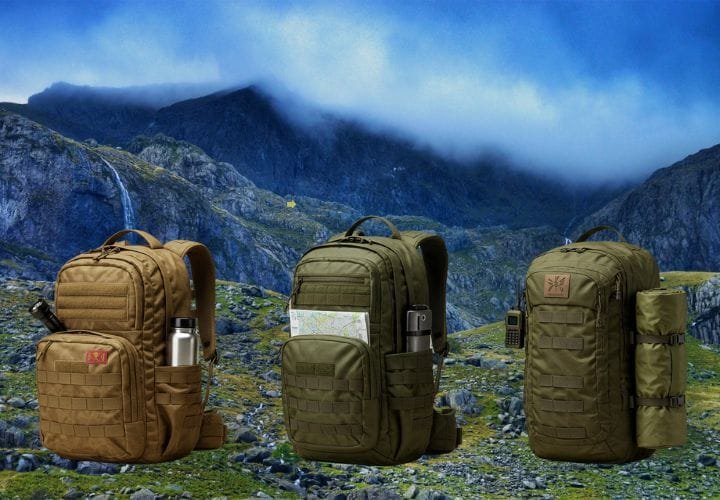
Getting ready for emergencies means picking the right tactical survival backpack. It should allow you to move easily and feel comfortable. Think about the different backpack types out there. Each one fits a special need and place.
The Grey Man Backpack is one to look at. Models like the 5.11 COVRT24 work well in cities. They don’t stand out too much but still have room for your important stuff.
On the other hand, a tactical survival backpack like the 5.11 RUSH 72 2.0 is made tough. It’s for those who need to carry a lot with them in the wild. These bags can take a beating and help you keep your things sorted on tough paths.
- Capacity: Your bag should fit at least 25 liters for basic needs, but more than 49 liters for bigger plans.
- Comfort: Make sure it has padded straps and a good back panel. This helps when carrying more than 20 pounds.
- Compartments: Having several pockets makes organizing easier. This way, you can grab what you need quickly.
- Ease of access: Some pockets should be easy to get into for things like first-aid kits or water filters.
Let’s look at how cost and weight can vary among different emergency kit levels:
| Kit Level | Weight Limit | Bag Size | Cost Range |
|---|---|---|---|
| Level 1 | Under 20 pounds | Over 25 liters | $400 – $1,100 |
| Level 2 | Under 35 pounds | Over 44 liters | $800 – $2,300 |
| Level 3 | Under 45 pounds | Over 49 liters | $1,050 – $2,750 |
Try to keep your survival backpack around 25 pounds. This makes it easier to carry in an emergency. Packing too much can slow you down and tire you out.
Bug out bags should cover your needs for up to 72 hours. They must have things like clothes, water filters, food, sleeping gear, first aid, and tools for survival. Choose a bag that fits whether you’re in the city or out in the wild. This will help you handle emergencies well.
Water: The Lifeline of Survival
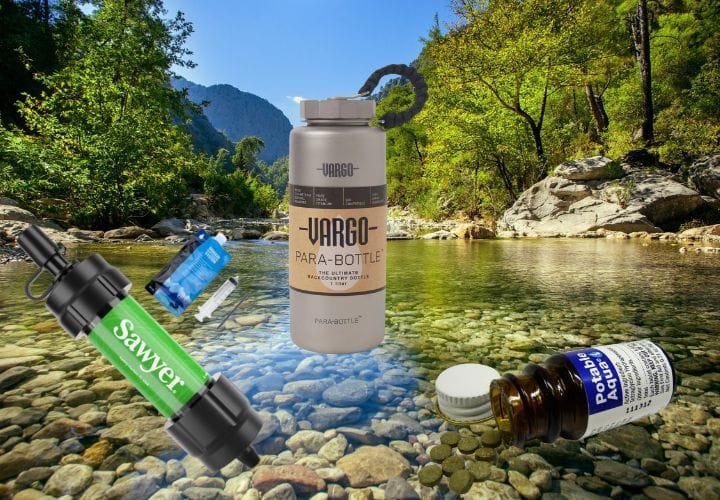
Water is vital for survival. Every gallon weighs 8.35 pounds and occupies 231 cubic inches. This shows how important carrying and storing water is. FEMA advises to store one gallon per person each day, for at least three days, in your emergency kit.
For durability and the option to boil water, stainless steel bottles like the Vargo Para-Bottle are top picks. Besides boiling, Potable Aqua purification tablets can make water safe.
Having more than one way to purify water, like the Sawyer Mini Water Filtration System, is smart. This system’s filter lasts longer, offering dependability for extended use.
- Vargo Para-Bottle Stainless 32oz – Ideal for tablet treatment and boiling water.
- Potable Aqua Purification Tablets – Effective for neutralizing harmful bacteria.
- Sawyer Mini Water Filtration System – Long filter life and compact design.
When carrying and storing water, picking the right containers is key. A tough 55L backpack gives you strength and space. A lighter backpack with internal frame is great for long treks. In the city, a 41L backpack works well without standing out.
Below is a table showing the features of these recommended backpacks:
| Backpack | Capacity | Features |
|---|---|---|
| Rugged Tactical Backpack | 55L | Unparalleled durability, ideal for heavy-duty use |
| Lightweight Practical Backpack | 55L | Internal frame support, suitable for long journeys |
| Discrete Urban Backpack | 41L | Highly functional, blends in urban areas |
By packing your Bug Out Bag with essential water supplies and purification tools, you’re ready for emergencies. Remember, how you handle carrying and storing water could save your life.
Food: Sustenance on the Move
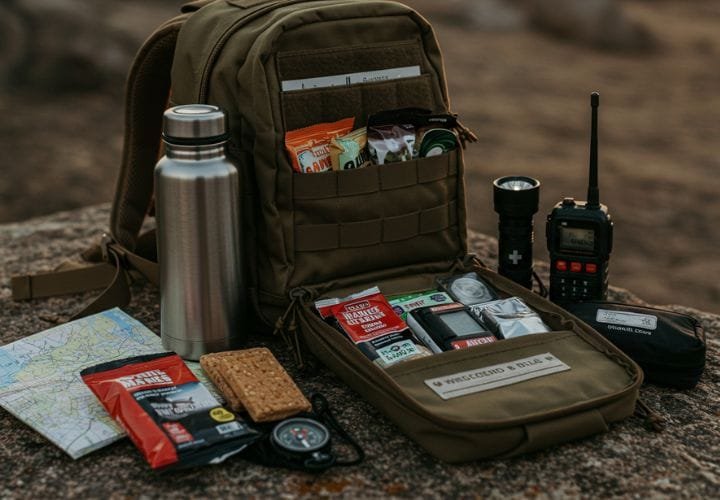
When you’re putting together your bug out bag, it’s vital to pick survival foods wisely. These foods should keep you energetic and healthy in emergencies. Here, we’ll explore the best food choices for your 72-hour emergency kit.
- Survival food bars are packed with calories and easy to carry. For example, Millennium Bars offer essential nutrients and last about a year. They’re great for keeping you going during tough times.
- Meals Ready to Eat (MREs) are famous for their nutritional balance. Used by the U.S. Military, they don’t require cooking and have a lot of calories. MREs are perfect for emergency situations.
Adding foods with a long shelf life is smart. For instance, *survival tabs* can last 25 years, offering vital nutrients and calories. *Freeze-dried foods* are also excellent; they stay good for decades if kept sealed. You can quickly make them edible again with water.
In choosing food for your emergency kit, look at nutritional content and how long it lasts. Below is a useful guide for *selecting the best survival foods*:
| Food Item | Shelf Life | Benefits |
|---|---|---|
| Millennium Bars | 1 year | High energy, compact, easy to eat |
| U.S. Military MREs | 5 years | Ready-to-eat meals, no cooking required |
| Survival Tabs | 25 years | Vital nutrients, very long-lasting |
| Freeze-Dried Foods | Decades | Keeps long, light, full of nutrients |
Don’t forget about hard candy for your kit. It gives you a quick sugar rush and lasts a long time. Also, keep your food supply fresh by checking and replacing it regularly. This avoids having any spoiled food during emergencies.
Choosing the right foods for your bug out bag means balancing nutrition, calories, and shelf life. By carefully *selecting suitable survival foods*, you’ll be ready for any crisis. It helps you stay energized and healthy when you need it most.
Shelter and Clothing: Protection from the Elements
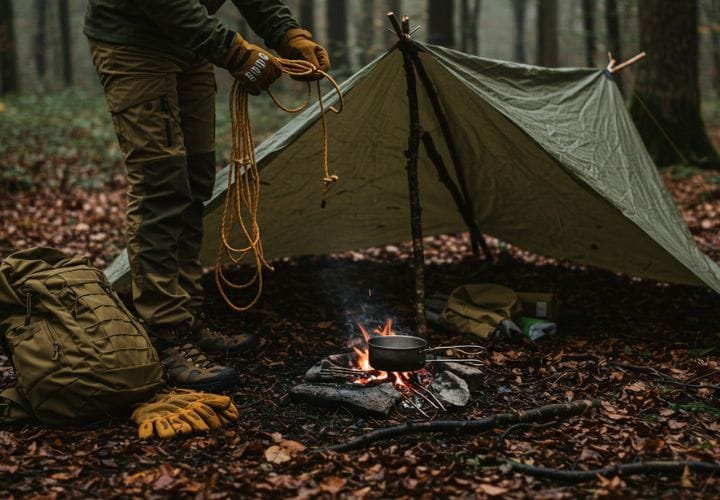
Shelter is a must-have in your BOB to safeguard against the elements. Having the proper emergency shelter and clothing can be a lifesaver.
Lightweight and Durable Shelter Options
Your bug-out bag needs lightweight, strong shelters like tarps and emergency bivys. They provide quick, secure refuge in various settings. Extreme weather can lead to severe conditions like hypothermia or heatstroke.
“FEMA recommends having at least one gallon of water per person per day for a minimum of three days.”
Layered and Adaptable Clothing
Choose clothes that can be layered and adapted. Moisture-wicking layers are key to stay dry. This prevents hypothermia and overheating. Insulating layers help keep you warm at night. Outer layers ward off wind and rain. These choices are crucial for your survival.
Essential Personal Protective Equipment (PPE)
PPE is vital for protection against environmental risks. N95 masks filter out harmful particles. Tough gloves protect your hands from injuries.
Here’s an overview of the essential items for your bug-out bag:
| Item | Purpose | Recommendation |
|---|---|---|
| Emergency Bivy | Instant shelter | Core component for any BOB |
| Moisture-Wicking Clothing | Regulate body temperature | Essential for all climates |
| N95 Masks | Protection from particulates | CDC recommends in emergency kits |
| Rugged Gloves | Hand protection | Prevents cuts and abrasions |
| Insulated Layers | Warmth during cold conditions | Vital for nighttime temperatures |
Understanding the importance of shelter in your BOB preps you for sudden weather shifts and challenges. Being ready with the right shelter and clothing helps you stay safe and move forward confidently.
Bug Out Bag Essentials: Emergency Preparedness Kit
When making your emergency plan, it’s key to build a complete Bug Out Bag. This bag should meet short-term survival needs and fit your situation. We’ll look at what to include to ensure you’re prepared for anything.
- Water and Hydration: Each person needs a gallon of water per day for three days. Lightweight containers like the Vargo Para-Bottle Stainless 32oz are good. Also, have water purifiers such as Potable Aqua Tablets and the Sawyer Mini Water Filtration System ready.
- Food Supplies: You should have non-perishable food for 72 hours. Millennium Bars and US Military MREs (Meals, Ready to Eat) are great. They offer the needed calories and nutrients.
- Shelter and Clothing: Pack a change of clothes for the weather. Include a light tent or emergency blankets for shelter. Choose durable items for protection against weather.
- Personal Hygiene: Bring items like toothbrushes, toothpaste, and soap. In health emergencies, include PPE such as N95 Masks (3M Aura 9205+) and gloves (Mechanix Wear Covert Gloves or Venom Steel Nitrile Gloves).
- Medications: Have a week’s supply of prescription meds and over-the-counter drugs like pain relievers and anti-diarrhea medicine.

- Fire Starting: It’s essential to have fire-starting gear. Pack a Windproof Arc Lighter and UCO Stormproof Match Kit. They’ll help you make fire and cook.
- Navigation and Communication: Your BOB should have a compass, maps, and an emergency radio. This helps stay informed and find safe paths.
- First Aid Kit: Include a basic first aid kit like the MyMedic Standard MyFak. It should have bandages, antiseptics, and medical supplies for injuries.
- Documents and Cash: Keep essential documents (ID, passports, insurance) in a waterproof bag. Have cash for times when digital payments don’t work.
Bug Out Bags are for short emergencies, about 72 hours to a week. It might take days for help to arrive. Being independent for three days is key. With these items, you’ll be fully prepared for any emergency.
Navigation and Communication: Staying Informed and Safe
The importance of navigation tools cannot be stressed enough. In any emergency, knowing where you are is key to survival. Maps and a compass help you figure out your location and where to go.
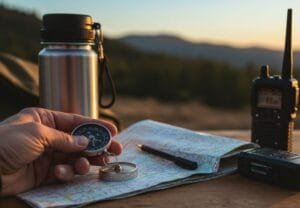
- Maps and Compass: These old-school tools are crucial. They don’t need batteriesand work even when tech fails.
- Emergency Radios: Emergency radios connect you to critical news. They’re key for weather updates and emergency instructions.
| Navigation Tool | Function | Importance |
|---|---|---|
| Compass | Orientation and direction | Critical for maintaining path |
| Maps | Geographical information | Essential for planning routes |
| Emergency Radio | Communication updates | Vital for receiving alerts |
To sum up, having the right navigation tools and communication devices in your emergency kit is vital. They help you stay informed and safe. Navigating through crises becomes easier.
Conclusion
Making a great Bug Out Bag (BOB) is key for staying safe if things go wrong. In this guide, we talked about how to pack a survival kit just right. It’s essential to pick a bag that fits your needs and where you live. You might need a big tactical backpack, one that’s perfect for the wild, or a smaller one for the city.
Water is a must-have because you can’t last long without it. Remember, a gallon of water is pretty heavy. So, we suggest having a metal water bottle, stuff to clean your water, and a filter. Also, pack foods that give you lots of energy but don’t weigh much, like snack bars and MREs.
Your BOB should have stuff to keep you warm and dry. A strong tarp, a bivy sack, and a heat-keeping blanket are smart choices. Don’t forget extra clothes, sturdy gloves, and something to keep the rain off. Tools to help you find your way and stay in touch, like a compass, maps, and a radio, are super important.
Lastly, add a first aid kit, ways to make a fire, and important papers to your BOB. Checking your kit often to update it is a good habit. This makes sure you’re always ready for anything. By preparing your Bug Out Bag well, you’re set for whatever comes your way. Stay prepared and stay safe.
FAQ
What is a Bug Out Bag?
A Bug Out Bag (BOB) is a kit that you can carry. It has all you need to survive for up to 72 hours if you have to evacuate quickly. This bag helps you leave fast in emergencies like floods, hurricanes, or fires.
When should you use a Bug Out Bag?
A Bug Out Bag is for emergency situations that need you to leave your home quickly. This includes natural disasters and man-made hazards. With this bag, you can leave quickly and have everything you need.
What essentials should be in a survival backpack?
A survival backpack should have items like water purification tools, food with high calories, and items for shelter. It should also have first aid supplies, tools for finding your way, and ways to communicate. Make sure to adjust what you put inside based on your needs and local risks.
What is a Grey Man Backpack?
A Grey Man Backpack doesn’t stand out but is still great for survival. These backpacks, such as the 5.11 COVRT24, are made to not draw attention in emergencies.
How do you choose the right survival backpack?
When picking a survival backpack, look at its size, how comfortable it is, and how it’s divided. Think about what kind of emergency you’re preparing for. Tactical ones like the 5.11 RUSH 72 2.0 work well for many situations. But for city use, a 5.11 COVRT24 might be better.
What are the best water purification methods for a Bug Out Bag?
For your Bug Out Bag, carry stainless steel bottles and purification tablets. The Vargo Para-Bottle is good for boiling water. With Potable Aqua, you can purify water easily. This way, you’ll always have safe water to drink.
What are the recommended food options for a Bug Out Bag?
For a Bug Out Bag, pack food that gives a lot of energy and lasts long. Survival food bars and Meals Ready to Eat (MREs) are good choices. Millennium Bars and U.S. Military MREs are examples that provide the nutrition you need.
What personal protective equipment should be included in a Bug Out Bag?
In your Bug Out Bag, include N95 masks, strong gloves, and various clothes you can layer. Also, pack a light and sturdy shelter like tarps or emergency bivys. These protect against bad weather and dangers from the environment.
Why are navigation tools important in a Bug Out Bag?
Navigation tools keep you aware of your surroundings in emergencies. You need compasses and maps to find your way. Emergency radios help you get updates and stay in touch with others while evacuating.
Source Links


